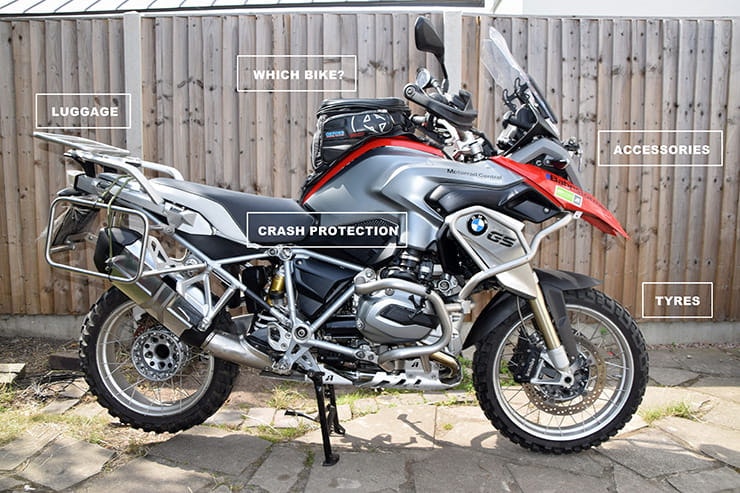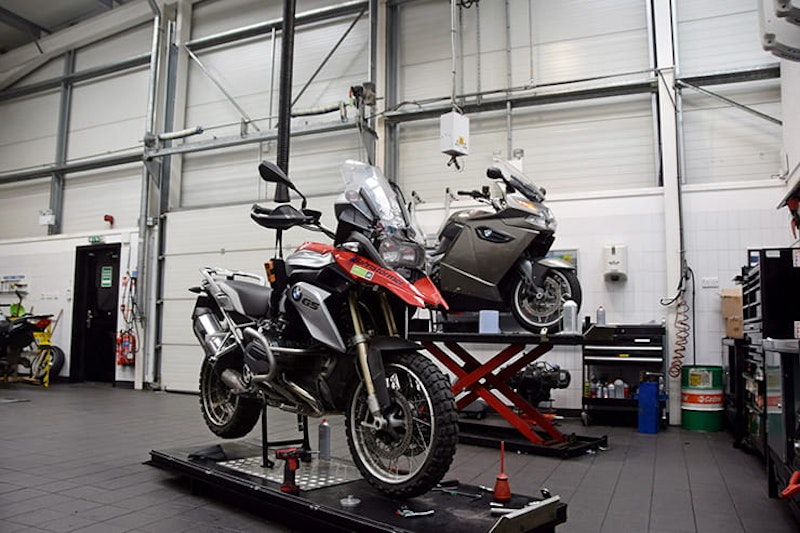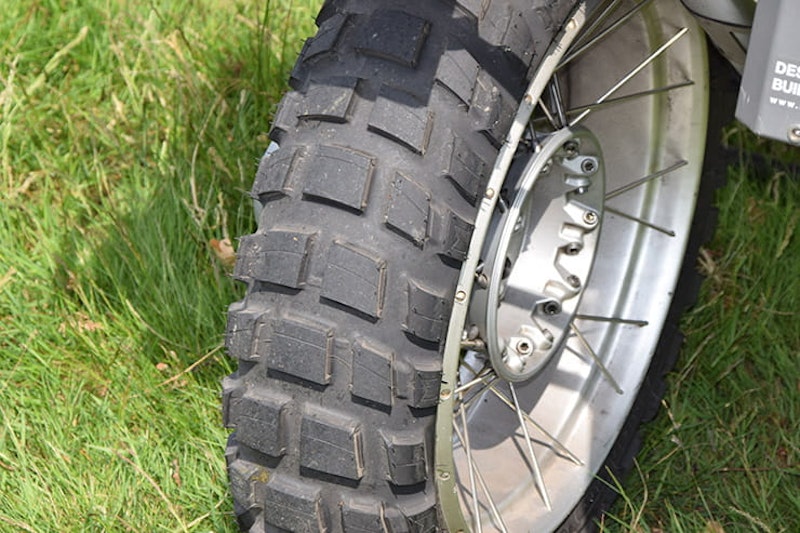When planning any trip, no matter how big or small, it's obviously important that your bike’s in good shape and as best equipped it can be. I've broken it down into five main areas; servicing, luggage, tyres, protection and accessories, and while specific to the bike I'm taking on the trip, most of it will apply more generally. It’s generally common sense really…
Make sure your bike is serviced before a big trip
BIKE SERVICING
Regardless of where you're going or for how long, you want to make sure your bike's well serviced before setting off. Consumables such as brake pads, chain and sprockets all need to be looked at and changed if you don't think they're going to last the trip. It's not impossible to pick up replacement parts along the way, but if you're limited for time then the last thing you want to be doing is hunting around for parts for the bike.
If your bike's going to have to be serviced on route (for instance, on a really epic journey), then research ahead to find out where best it can be done. For this trip to Iceland I plan on covering around about 5000-6000 miles – my BMW R1200GS has 6000 mile intervals, so I can have it done before leaving. I run an extended warranty, so need to have it professionally serviced – the bike was due one anyway before the trip, but if I was mid-way through an interval I'd probably get it done anyway, just to save the hassle of finding somewhere to do it out there.
If you're servicing your own bike, and will need to do it along the way, then take the service items that might be difficult to come across, such as air and oil filters. Oil is easier to get hold of, but if your bike uses a specific grade then it can sometimes be harder to get.
The main thing is to have faith in your bike before setting off. Obviously things can still go wrong, and if they do then deal with them at that time. Try not to worry about the things that might or could go wrong before they've even happened because chances are you'll have no problems.
Nathan’s using the Michelin Anakee Wilds for his adventure
TYRES
Tyres are always a tricky one to get right as everyone has their own opinion. I'd say stick with what you know and trust. If you're still not sure what to take then look for people who have done similar trips, or done mileage on similar bikes to get a good feel for what works. For this trip I've fitted another set of Michelin Anakee Wilds as I know they'll offer the best compromise of road, off-road and wear rates. With all tyres it's a compromise, so before deciding what to fit, figure out what you need most; performance, price or wear rates. If I were just riding Tarmac roads then I'd fit a set of regular Anakees.
If your trip is longer than a set of tyres will last then do some research into where's best to get a replacement set. Forums such as www.horizonsunlimited.com are great for this, with travellers sharing such details as good tyre fitters in different places. Some people choose to carry a fresh set of tyres with them, which is another, albeit bulky option, but at least you know you've got them when you need them.
If using tubeless tyres, take a repair kit. If tubed then consider taking spares tubes, or use one of the puncture prevention gels such as Slime. Some have suggested that for Iceland I take spare inner tubes, even for these tubeless tyres, which might be a good idea if I get a big tear in the sidewall for example, but for things like that I'd rather leave it to chance as you can't equip yourself for every eventuality. And there’s a BMW dealer on the island, should the worst happen.
LUGGAGE
In terms of what type luggage to go for, there are generally two options; hard or soft. The benefit of the hard pannier is that they're more secure, usually watertight and are easier to pack and keep organised than soft luggage. The downside is that their frame and construction adds a lot of weight, they generally make the bike wider and they’re usually expensive to buy. Many of the popular adventure bikes come with their own hard luggage in the accessory catalogue – these standard fitments are perfectly adequate for most trips, but if you want something stronger and sturdier consider the after-market suppliers such as Touratech, Metal Mule, Stahlkoffer, Holan, Jesse, Givi or SW Motech. The GS will be running a set of Metal Mule Utes for the Iceland trip; a pannier I've already used and like.
Alternatively, the benefit of soft luggage is that it reduces the weight, it's a narrower fit to the bike, and, for off-road riding, it's that bit safer as you can't get your leg trapped under it in the event of a crash. The downside is that it's hard to make waterproof, doesn’t generally have the load capacity of hard luggage, and can be difficult to mount, requiring some sort of frame or system to stop it fouling the rear wheel, or – if your bike has high level exhausts – catching fire from the heat (as I know all too well from a recent roll bag fire on a Husqvarna TR650). Companies such as Kriega and Giant Loop do a good selection of soft luggage, as do Oxford and Givi.
Another option of course is a top-box. These are a good solution if you need more fixed space, and convenient for when you don't have the side panniers attached. My preference has always been for a soft dry bag across the back, which allows more flexibility and width for getting tents and other camping gear in; Scottish brand Lomo is another brand worth considering. I have a Metal Mule rear rack, which gives something to strap the bag onto without interfering with pillion passenger space, also acting as a backrest. Rough and corrugated roads – which I'm likely to find in Iceland – could also put too much stress on the mounting points of a top box, so a soft roll bag is likely to be more damage-resistant.
Last but not least, a good tank bag is always handy to have for things you need to hand, such as a camera, chargers, passport, paperwork and the odd bit of food. Most aren't waterproof, but come with waterproof covers. My preference is for those with a transparent top, allowing me to put maps or sat-navs underneath and still be able to see them.
The best bet is to have a system – have everything in a set place as that will help you keep organised when living off the bike for a prolonged period of time. Divide the panniers up into 'living areas'; kitchen, bedroom, wardrobe etc, and don't panic if you take too much to begin with. Everyone does it. Everyone overpacks.
Before the trip, make a list of everything you absolutely must take; be it camping gear, waterproofs, tools etc. And try not to add to that unless absolutely necessary. You generally will not need half of what you think you do, but it's an ongoing learning curve.
CRASH PROTECTION
If you're riding in unfamiliar terrain, especially if some of it is away from the Tarmac, then you can almost guarantee that at some point you'll have a topple. The worst disaster would be for a trip to be ended this way, so it’s always good to consider ways in which you can protect your bike from damage.
The R1200GS is pretty easy to protect as you can bolt on a set of cylinder head bars – if the bike falls on its side then it just lands on them. For the last few years I've had the AltRider bars fitted – an American brand that might look a bit industrial, but mine have taken a fair few knocks along the way. You can buy engine protection for most bikes, and while they don't always look pretty, if they prevent you from cracking your motor’s casing in the middle of a trip, then that's no bad thing.
Because of the stoney surfaces of Iceland, I've also fitted radiator guards, though am noticing they do make the bike run hotter, so as with all modifications, you need to keep an eye on them to make sure they've enhanced the bike, not made it worse!
Hand-guards are also useful to have, protecting brake and clutch levers in the event of a spill. A lot of bikes have snap-off points an inch or so in from the end of the lever, meaning that you don't lose it all if they do hit the floor. Taking spares isn't a bad idea either anyway.
Possibly the best way to avoid an off is to undertake some training, especially if you plan on riding off-road. These 'adventure' bikes are capable in a bit of dirt, but things can turn ugly pretty quickly if you don't know what you're doing. There are loads of training centres, including the BMW Off Road Skills course, Honda’s off-road centre, Sweet Lamb Adventure Academy and Yamaha Off-Road Experience. The MotoScotland training facility up near Inveraray in Scotland is also excellent. None of the courses are necessarily cheap, but they could save you a lot of time and money – the idea is to build up your confidence, not turn you into an off-road hero, and all are worth the investment.
ACCESSORIES
Sometimes less is more when it comes to accessories. You want the stuff that's going to make life easier on the trip, not just add clutter to the bike with no real gain.
The most important thing, I think, is a 12V charger. More bikes should come with them as standard, but if yours doesn't have one then they're worth fitting, if only to charge smart phones and sat-nav while on the move. Fitting them can be awkward if you don't know what you're doing, and if you’re unsure consider paying a specialist. The GS comes with a socket as standard, to which I've connected a twin USB adaptor, or there are plenty of USB chaging sockets that can also be wired to your battery – useful for the phone if you already have a sat-nav hard-wired in.
The sat-nav is another popular addition, with plenty of bike-specific units on the market. I just use a TomTom car unit under the transparent cover of my tank-bag and charge it through the USB port. Not the most sophisticated set up, but it does the job.
Also consider a bike's weaknesses. I know that the screen struts on the BMW can be prone to stress fracture if you do a lot off-roading, so I've fitted a set of Cymarc screen braces that stop the screen from flapping about. The only other accessory I’ve fitted is a tool tube. This is a cheap (£15) plastic tube that you attach to the bike – the quick way being with tie-wraps –to store all your tools in. It gets them out of the pannier and reduces clutter, which is one of the key things when travelling any distance.
TOOLS TO TAKE
Another part of bike prep is getting a tool kit together. As always there's no right or wrong. My opinion is take only what you know how to use and pack sparingly. For this trip to Iceland I'm taking tools needed to remove front and back wheel, including necessary Torx heads for adjusting the handlebars, removing the front brake fluid reservoir and for tightening and checking panels and bolt heads.
Because of the premature wear rate of rear brake pads due to the linked braking system, I'll also take a spare pair of rear pads, and due to the bike being used off-road a fair bit I'll also pack a spare set of front wheel bearings, as they can fail sooner than usual. Just in case of brake fade, which I’ve had in the past, I'll take a brake bleeding hose and a bit of spare fluid.
As I like to take my own, specific grade of oil, to avoid cluttering the pannier up, I bolt an spare oil bottle to the outside of the pannier.
Another vital tool for this trip is the right socket to get the spark plugs out. With river crossings aplenty across Iceland's interior, you run the risk of drowning the bike should you drop it. If that happens then turning the engine over with the plugs out should clear out the cylinders. The benefit of the GS with its boxer engine is accessibility to the cylinder heads. It shouldn't be too big a job to take the plugs out, but on a V-twin or even some singles it can be a lot more time and effort. Hopefully I'll not need to find out.
Other than that it's just a case of a tubeless puncture kit, a pump (I'm taking one that connects to the battery and stores neatly under the seat), not to mention the all-important tie wraps and gaffer tape. It's probably also worth taking some chemical-metal repair for any emergencies, such as a cracked cylinder head cover – even with engine bars you can still crack the head with a protruding rock. Cylinder heads guards would be ideal, but time and money have put paid to that.
Obviously if there were a few of you going together you could split the load and organise yourselves so as to not bring the same tools. It's slightly unnerving that I can't get breakdown cover for Iceland, but experience tells me not to worry unduly, and if the worst was to happen and the bike was to break down then you'd find a way around it. If push comes to shove, I could arrange for the stricken bike to be taken to the port and have it recovered at the other end when my breakdown kicks back in in Denmark. Hopefully that won't happen!
BIKE CHOICE
Last but not least it's important to stress that there is no right bike for any of this. All bikes are compromised and it's just where you decide to accept the compromise. The GS will be great for getting up to Denmark and also for two-up touring when my wife flies in. For solo exploration of the interior I'd ideally prefer to be riding something lighter and simpler, such as a single cylinder 650cc, or even something smaller.
If you sea-freight the bike across – saving the long ride up to Denmark – you could quite easily explore on a 125cc or even a scooter. The main thing is that you take the bike that you enjoy riding and not worry too much about what other people say or what you think you should take. As with all trips, just go on the one you've got...
TRAVEL INSURANCE
Just like any holiday, a trip on a motorcycle – be it in the UK, Europe or beyond – can be ruined by delays, lost documents, illness and more. There are plenty of travel insurance options, but you need to make sure you get a policy that includes riding motorcycles, and if it does, that it's for bikes of the engine size you'll be riding (many only cover up to 250cc). At its most basic, you should look for insurance that provides cover for the following:
Medical expenses
Loss or theft of personal possessions
Lost or delayed luggage
Loss of your passport and other documents
Travel delays and disruptions
Having to cut your holiday short
In addition though, if you’re taking a motorcycle (or you're renting one while you’re away) be sure that your insurer will cover you for any medical expenses, should you have an accident. You must also think about where you’re riding – some policies won’t cover you if you’re trail or enduro riding, or if you’re on a race track. Remember – this isn’t about your bike being covered, it’s about your medical expenses, should the worst happen.
If you're only going away once, a single-trip policy will likely be all you need, but also consider an annual policy, which could extend to cover your family holidays too (a good insurer should also be able to offer cover for your whole family).
Which bike for an adventure, and how to prep it...
Nathan explains his choice of bike, and how to prep for any motorcycle adventure…
Share on social media:


